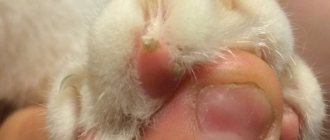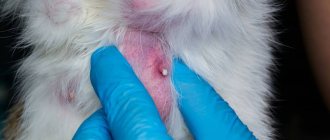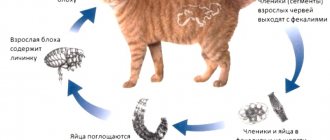The diseases that pets suffer from are quite simple and common, and sometimes they are rare and unusual in their manifestations. These diseases include cutaneous horn. With this pathology, growths appear, each of which looks like a claw growing, for example, on the pad of a cat's paw.
Signs of appearance
In veterinary medicine, this disease is diagnosed quite rarely. And the cat owner may even mistake it for an ordinary claw. Upon closer examination, you can see that this growth:
- dense and hard to the touch;
- with a rough surface;
- conical or cylindrical;
- light or dark color;
- does not exceed 5 cm in length.
Most often, growths appear on the paw pads, but they can also appear on the eyelids, on the nose, and near the animal’s anus. According to the observations of veterinarians, representatives of the Scottish or British breed of cats are especially susceptible to this disease.
Features of the pathology
The skin horn can be light or dark in color and has a dense consistency. The surface of the growth is rough due to the presence of grooves. The size of the neoplasm on the cat's paw pad does not exceed 5 cm.
When a growth appears, the pet does not experience any discomfort, and the formation itself is most often benign. When pressing on the “skin horn,” the cat may experience discomfort due to the fact that the appearance of the growth is inflammatory in nature.
In 5% of cases, horny growths on a cat’s paw pads indicate oncology. If a skin pathology is detected, the pet owner should not try to eliminate the formation on their own. It is easy to purchase one of the recommended medications at the pharmacy, which will stop the process of skin horn development.
[custom_ads_shortcode2]
Reasons for appearance
The appearance of such growths is a pathology in which the process of keratin formation and keratinization of cells in the upper layer of the skin occurs too intensely.
The development of the disease can be caused by various provoking factors. The most common of them is the presence of papilloma virus in the animal’s body. It has the ability to transform epithelial cells, causing the growth of warts, growths on the paw pads of cats or other skin formations.
The causes of neoplasms may also be:
- Injury to the claws, their break at the very base or complete separation. In this case, when a new claw is formed, excessive growth of skin tissue is possible.
- Chemical burn or other damage to the skin. The affected area of skin needs a new layer. At the site of damage during the regeneration process, keratinization occurs faster and a so-called horn can form.
- In addition to the papilloma virus, neoplasms and tumors can provoke another fatal disease. The causative agent of viral leukemia suppresses the animal’s immunity and promotes the growth of malignant tumors.
- In most cases, growths in cats are not dangerous and are benign. However, about 5% of neoplasms are malignant. They may be symptoms of squamous cell carcinoma or another cancer.
- In some cases, the pet's growth may turn out to be a cyst.
Surgical methods
If drug therapy is ineffective and the growths have spread over a large area, it is usually more advisable to subject the cat to surgery to remove them. In such cases, they resort to cryotherapy, laser surgery, or remove growths with a scalpel.
Laser removal is the safest and most painless, since during it there is no direct impact of medical instruments on the skin and does not leave marks on the skin. During cryotherapy, skin formations are frozen with liquid nitrogen. This procedure is very painful for the animal.
If the neoplasm is not malignant, it usually does not cause much discomfort to the pet. Despite this, you should not ignore the appearance of any skin growths in a pet, carry out diagnosis in time, and do not self-medicate in doubtful cases.
Cutaneous horn in cats is a rather rarely diagnosed pathology in traditional veterinary medicine, which is characterized by the appearance of a horn-like conical, cylindrical keratin growth up to 5 cm in length.
In appearance, the formation, consisting of hard acellular keratin, resembles a claw or horn of light or dark color. Most often in cats, the pads of the paws are affected, less often on the face, in the area of the nose, eyelids, and genitals. The disease has a benign course.
[custom_ads_shortcode2]
Drug therapy
To eliminate cutaneous horn in cats, the necessary treatment is selected only after conducting research, studying tests, and establishing the cause of the pathology.
In some cases, when there is no need for surgical intervention, it is permissible to treat your pet at home. You can treat yourself using medications that are prescribed by a veterinarian. For a certain form of the disease, the most suitable drugs are used.
When the disease is viral in nature, various immunomodulators are used. Such drugs include Aldara cream. When the cream comes into contact with the skin, the substances included in its composition stimulate the body’s immune response and increase the production of interferon.
Rules for using the drug:
- it is applied directly to the affected area, rubbed until completely absorbed;
- treatment is carried out no more than 3 times a week, every other day;
- It is necessary to ensure that the cat does not lick the medicine.
The product "Acitretin" is classified as dermatotropic and has the following properties:
- stimulates tissue regeneration;
- promotes the resorption of scars;
- normalizes the processes of skin keratinization;
The drug must be used strictly under the supervision of a veterinarian, since its mechanism of action remains unknown.
You should know that such remedies only eliminate skin keratinization, affecting only the symptoms of the disease, but not its cause.
To act directly on the causative agents of skin infections, antibiotics should be used. Azithromycin is an antimicrobial drug that is effective against a wide variety of microorganisms. They are usually treated with antibiotics for 10 to 14 days.
Diagnosis and treatment of cutaneous horn in cats
The diagnosis is made on the basis of characteristic clinical symptoms, medical history, serological and bacterioscopic studies carried out in a veterinary clinic. Screening for the presence of leukemia virus in the cat’s body and the necessary histological examinations are mandatory. In doubtful cases, a biopsy and differential diagnosis are performed. All cats, without exception, must be examined for virus carriage. Having noticed an uncharacteristic pathological keratin growth on your furry pet, you should not let the problem take its course, much less try to remove the skin horn. Any neoplasm provokes inflammatory processes in various structures of the dermis. Keratin growth destroys tissue and may grow uncontrollably. Adequate therapeutic therapy can be prescribed only after a comprehensive diagnosis and identification of the root cause.
Important! Despite the benign course, the prognosis depends on a number of reasons, the main root cause.
In most cases, treatment for cutaneous horn in cats involves surgery. Surgical excision of the lesions is performed under general or local anesthesia. In asymptomatic cases, constant monitoring and symptomatic drug treatment are possible. Cryo-laser therapy can be performed. In case of a mild form of the disease, in the initial stages, veterinarians recommend treating the cutaneous horn in cats with pharmacological agents (synthetic retinoids) that prevent further pathological growth. Four-legged patients may be prescribed:
- Azithromycin in tablet form.
- Acitrine. The drug is used under the strict supervision of a veterinarian.
- Aldara ointment. Apply a thin layer to the affected area three times a week. Rub the ointment until completely absorbed.
However, none of the above treatment methods provides a 100% guarantee that the growths will not appear again after some time. Pharmacological agents slow down, eliminate the processes of intense keratization, and relieve inflammatory processes in the affected tissues.
Remember, in order not to harm your pet, do not self-medicate. A veterinarian will select effective therapy for the fluffy.
Cases when growths appear on a cat's paws are not uncommon. Externally, the keratinized layer of skin resembles a second claw, which is why it received the name cutaneous horn. Most often, growths appear on the animal's paw pads (in rare cases, in the area of the nose and eyelids).
Such a skin pathology may not cause pain to the cat, so the pet can live with it all its life. In most cases, growths on the paw pads of cats are benign, however, there are exceptions.
[custom_ads_shortcode1]
Allergens in food
With a chronic latent course, the skin is constantly dry and flaky, the coat is brittle and dull, there is no itching. Although the wet type is also possible - weeping, highly inflamed and reddened areas of the skin, on the surface of which ichor constantly appears.
It is almost impossible to cure atopic dermatitis caused by a reaction to an allergen in food. However, a cat can live a full and happy life if the allergen is identified and its entry into the body is stopped. To do this, you need to take blood tests (it’s better to immediately do an extended analysis for 24 positions) and, together with a veterinarian, choose a diet.
Home treatment
For mild forms of pathology, treatment can be carried out at home. The use of pharmaceutical products helps prevent the growth of the growth in the future. On the positive side, the medicine “Etretinate” has managed to prove itself.
It is prescribed at a dosage of 1 mg/kg of pet’s weight. Give the product to your cat carefully, as it can accumulate in the animal’s body.
The use of Aldara cream is also quite effective in the fight against pathology. It must be used 3 times a week. Apply the product to cleansed skin and rub in until completely absorbed. When using the cream, it is important to ensure that the cat does not lick it off his paw pads.
A medicine such as Acitretin will allow you to get rid of the appendage on your cat’s pad. It is recommended to use it under the supervision of a specialist, since the drug in some cases causes side effects. The medicine is quickly eliminated from the pet’s body and has a short half-life.
Azithromycin tablets are another effective way to get rid of pathology. The medicine should be given once a day, and the course of treatment lasts two weeks. The dosage of the product is 10 mg/kg of pet’s weight. The pharmaceutical product is inexpensive and at the same time quite effective.
[custom_ads_shortcode1]
Kinds
There are several types of papillomas in cats.
Oral papilloma
The most common type of warts is found in meowing mustaches 6-9 months old. They appear in the oral cavity, most often on the tongue. Papillomas are oval elevations (numerous) with a flattened top. Warts are usually 4-9 mm wide (diameter).
Multiple viral
Multiple viral papillomas appear in older cats (elderly or middle-aged). Lesions occur over the entire surface of the body (there is no specific localization). The warts are numerous and vary in size (from a few millimeters to 3 cm). There are elongated ones, and in the form of pigmented plaques, and compactions (hyperkeratosis). Some of the papillomas may “degenerate” and the animal will develop squamous cell carcinoma.
Single skin papillomas in cats
This type of papillomas in cats is extremely rarely recorded. Single small warts are observed on the pet's skin. Most often, the disease develops in adult whiskers. Scientists have not been able to prove that this type of wart appears due to a virus.
When to contact a specialist?
It is necessary to visit a veterinarian if there are a large number of growths on the back legs of cats (or on the front legs). If your pet is unwell and the regular occurrence of pain during the animal’s movements should also be a cause for concern.
In addition to drug treatment, the veterinarian may offer the following treatment options:
- Laser surgery. In this way, it is possible to safely get rid of the growth on the animal’s paws. The laser leaves no traces and allows you to effectively fight the virus;
- Surgical method. Used if the area of build-up is too large. Using a scalpel, skin pathology is eliminated, however, after the operation, scars may remain and formations may reappear;
- Cryotherapy. This is a painful procedure, as the skin lesion is treated with liquid nitrogen. A dry crust appears at the site of the growth after the procedure;
None Some cat owners use traditional methods to treat growths. These include the use of aloe leaves, propolis, juniper and bay leaves, as well as the use of vegetable oil.
You can prevent the occurrence of such a pathology if you carefully monitor your pet’s health. It is important to notice changes in his health and undergo a preventive examination with a veterinarian twice a year.
Text of the article and photos from the book SMALL ANIMAL DERMATOLOGY A COLOR ATLAS AND THERAPEUTIC GUIDE 2022 Translation from English: veterinarian Vasiliev AV
[custom_ads_shortcode2]











